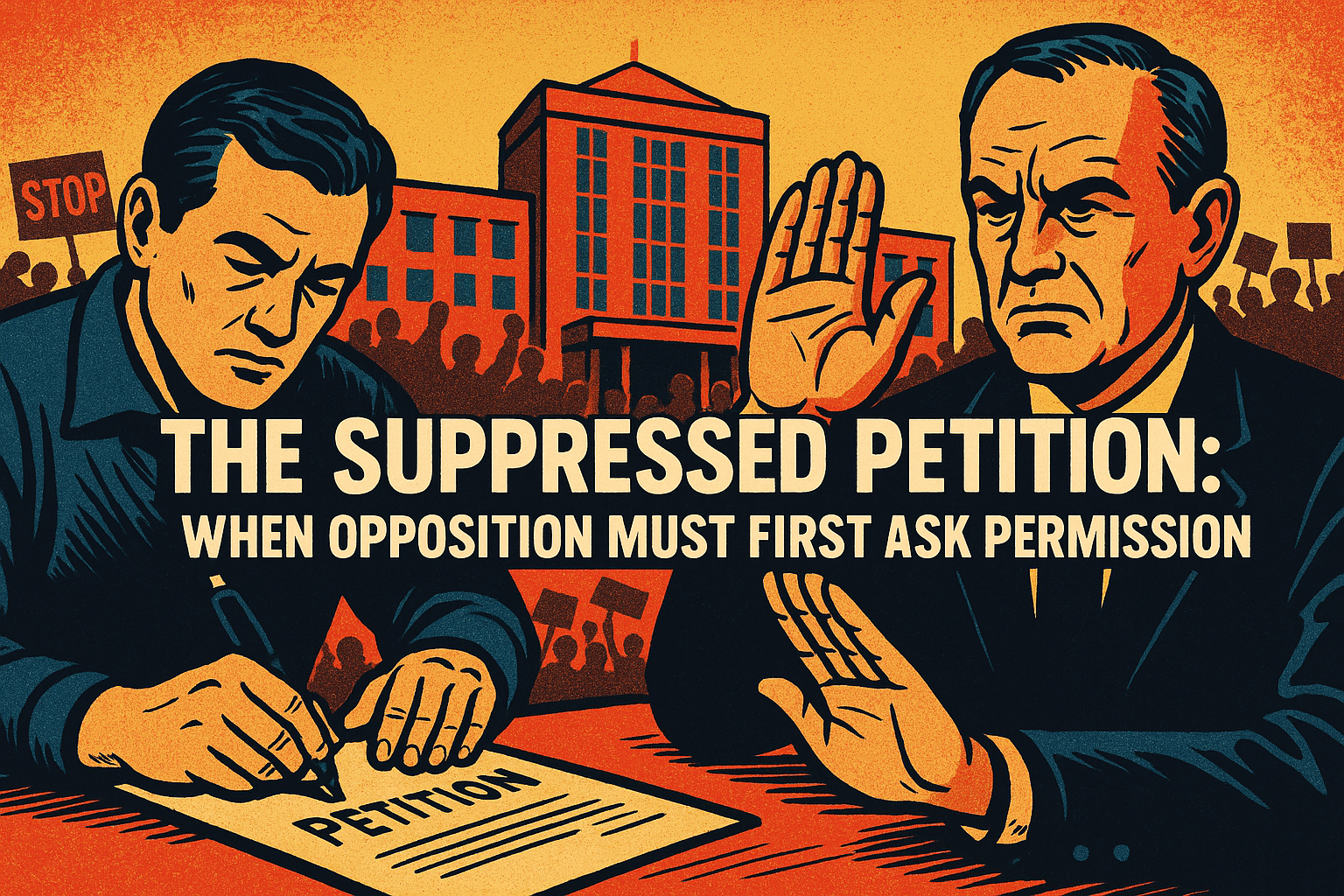Grassroots dissent is often presented as democracy in action. Yet in Newfoundland, opposition rarely grows freely. It is filtered, formatted, and filed—managed through channels designed to suppress its force.
One story, told to me about Rae Miller’s attempt to oppose development, captures the contradiction. The town organized and circulated a petition, but Miller refused to pass it on to a Member of the House of Assembly (Eddie Joyce). The signatures of local residents were not enough on their own; the petition’s very existence depended on being carried by the same political system it was challenging. The petition wasn’t resistance; it was an application to resist.
This is not just bureaucratic red tape. It is the architecture of Newfoundland governance. Dissent is converted into procedure, and procedure is where opposition goes to die.
Asking Permission to Oppose
The paradox of a “suppressed petition” is stark. Instead of being an act of defiance, the petition becomes a request: may we please oppose you? The very form that is supposed to embody grassroots power becomes a tool of containment. Those who play by the rules are shunted into long processes, where their voices can be dismissed as “not in scope,” “not substantial,” or “not timely.” Those who refuse the format are painted as illegitimate, unreasonable, or simply ignored.
The Local Paradox in Action
Scholars call this the local paradox: communities are included in energy and development decisions only through structures that make real resistance impossible. In Newfoundland, “participation” is routinely offered through comment periods, advisory committees, and petitions that operate inside state or consultant frameworks. This allows government to claim openness while ensuring control of outcomes. As Van Assche et al. observed, local opposition is welcomed only when it can be contained within projectized forms of consultation.¹
Municipal weakness intensifies the problem. Most towns are too small and fiscally fragile to resist. They depend on provincial transfers, operating grants, or outright bailouts. This is the essence of the soft budget constraint: when municipalities know they will be rescued, they cannot act independently.² The concept, first described by Kornai, highlights how repeated bailouts create dependency, suppressing local initiative and reinforcing provincial control.⁴ Any opposition movement that runs through these channels must first acknowledge the province as gatekeeper.
Historical Patterns of Managed Opposition
This system of “permission to resist” has a long pedigree in Newfoundland:
- Resettlement Programs (1960s onward)
- Under the 1965 Resettlement Act, a community had first to hold a public meeting (with 50 % of householders attending), pass a resolution, and then draw up a petition signed by 90% (later 80%) of householders to support resettlement to a designated “growth centre.” A justice of the peace had to verify the signatures.⁵ Even though labeled “voluntary,” the process was contentious: the consultative framework and the binding vote mechanics created pressure on communities, internal conflicts, and coercive dynamics.⁶
- Example: In Pushthrough, Newfoundland, the petition read: “We, the householders … hereby indicate our desire to move and Petition for assistance under the Fisheries …” — the formal petition was part of a top-down scheme dressed as community decision.⁷
- Rural / Regional Development Associations (RDAs)
- In the 1960s, rural development associations emerged partly as reaction to resettlement and modernization policies. Local leaders sought to assert voice over industrial and social policies. But the movement was soon co-opted: by the late 1970s and 1980s, RDAs were refocused under federal-provincial funding agreements and aligned with government agendas.⁸ Over time, RDAs shifted from grassroots advocacy to service delivery and project implementation roles, losing capacity for independent critique. Bonia’s research documents how these grassroots RDAs, once more autonomous and locally oriented, steadily became subject to external control—their budgets, mandates, and staffing increasingly determined by higher levels of government.⁹
These cases show how grassroots energy was directed through state-sanctioned formats that ensured control remained above. The people may have spoken, but only within boundaries drawn for them.
How Petitions Suppress
Petitions and consultations work as pressure valves. They relieve anger without altering outcomes. They can be ignored, delayed, or declared insufficient. Their very existence creates the illusion that dissent has been heard.
Compare the asymmetry: corporations never need permission to pursue their interests. Governments rarely ask if communities consent before announcing projects. But when people oppose, they must seek recognition—sometimes from the very office pushing the project forward.
The mechanics are simple:
- Procedural dilution: issues narrowed until opposition falls outside the official frame.
- Temporal control: deadlines and stages set to outlast local stamina.
- Legitimacy trap: once dissent is “heard,” government can claim the process is complete—even if nothing changes.
From Fishery Collapse to Wind Projects
The containment of opposition is not new. After the cod moratorium, communities that tried to resist relocation or plant closures found themselves steered into committees and programs where protest became “input.” Decades later, the same happens with energy projects.
Hogan’s research on wind energy acceptance shows how communities evaluate projects through the lens of past disruptions—from cod to Churchill Falls to Muskrat Falls.³ Locals may support small projects, but skepticism deepens when decision-making is centralized, ownership external, and consultation tokenistic. Historical memories of failed development condition today’s acceptance—and today’s opposition.
The Illusion of Representation
The suppressed petition embodies Newfoundland’s deeper governance problem: a culture where opposition must first bend the knee. To object, one must play by rules designed by the very actors being opposed. The result is not empowerment but neutralization.
And so petitions pile up, consultations close, reports gather dust. The opposition has been heard—because it was never meant to matter.
Conclusion
A suppressed petition is worse than silence. It creates the performance of democracy without its substance. By asking permission to resist, communities affirm the legitimacy of the very structures that erase them.
If opposition in Newfoundland is ever to matter, it cannot rely on formats that require consent from above. The lesson is clear: dissent that asks permission is not dissent at all—it is management.
See More
- Rehearsed Truth: How Repeating the Same Story Keeps Newfoundland Stuck
- Imported Outrage, Local Silence
- Kingmaker Dynamics in Newfoundland: Local Gatekeepers and the Politics of Silence
References
[1] Van Assche, K., Greenwood, R., & Gruezmacher, M. (2022). The local paradox in grand policy schemes: Lessons from Newfoundland and Labrador. Scandinavian Journal of Public Administration https://www.sciencedirect.com/science/article/abs/pii/S0956522122000197?via%3Dihub (Local Download)
[2] Guo, X. (2025). Optimal Transfer Mechanism for Municipal Soft-Budget Constraints in Newfoundland. https://arxiv.org/abs/2508.02171v3 (Local Download)
[3] Hogan, J. L. (2025). The legacy of the cod fishery collapse: Understanding wind energy acceptance in Newfoundland through energy justice and place. Energy Research & Social Science, 127, 104274. https://doi.org/10.1016/j.erss.2025.104274 (Local Download)
[4] Kornai, J. (1986). The Soft Budget Constraint. Kyklos, 39(1), 3–30. https://doi.org/10.1111/j.1467-6435.1986.tb01252.x
[5] “The Resettlement Program.” Newfoundland & Labrador Heritage. Memorial University / Department of Education. https://www.heritage.nf.ca/articles/politics/resettlement-program.php
[6] Côté, I., & Pottie-Sherman, Y. (2020). The Contentious Politics of Resettlement Programs: Evidence from Newfoundland and Labrador. Canadian Journal of Political Science, 53(1), 1–23. Cambridge University Press. https://www.cambridge.org/core/journals/canadian-journal-of-political-science-revue-canadienne-de-science-politique/article/contentious-politics-of-resettlement-programs-evidence-from-newfoundland-and-labrador-canada/71595936DDE6B6DCD9BD9A5B13C71D6E
[7] Heritage NL. “The Resettlement of Pushthrough, Newfoundland, in 1969.” Newfoundland & Labrador Studies. https://journals.lib.unb.ca/index.php/nflds/article/view/25133/29082
[8] Municipalities NL. “Municipalities & Regional Economic Development.” Government of Newfoundland and Labrador. https://municipalnl.ca/site/uploads/2016/07/Municipalities-and-Regional-Economic-Development-.pdf
[9] Bonia, L. (2006). Regional Development Associations in Newfoundland and Labrador. MA Thesis, Memorial University of Newfoundland. Memorial Scholarly Archive: https://memorial.scholaris.ca/items/6ee3ded5-02c1-4f28-abdf-ac4ba6cc3a17 | Memorial Research Repository entry: https://research.library.mun.ca/10176/

